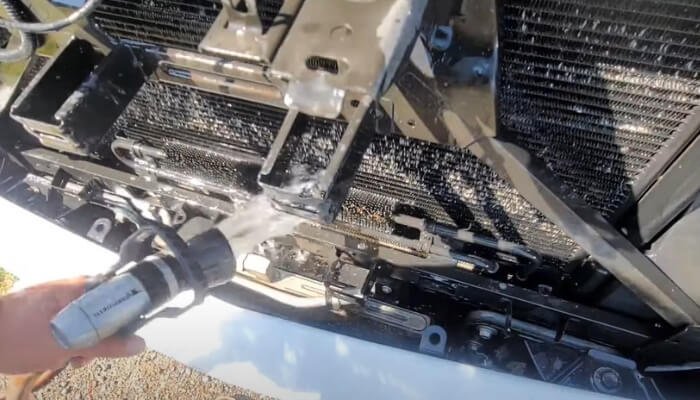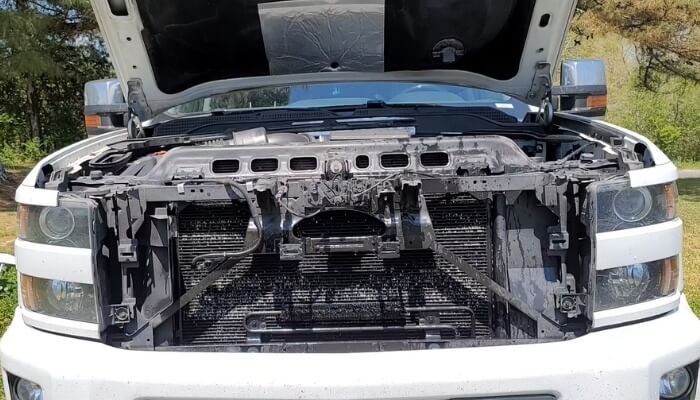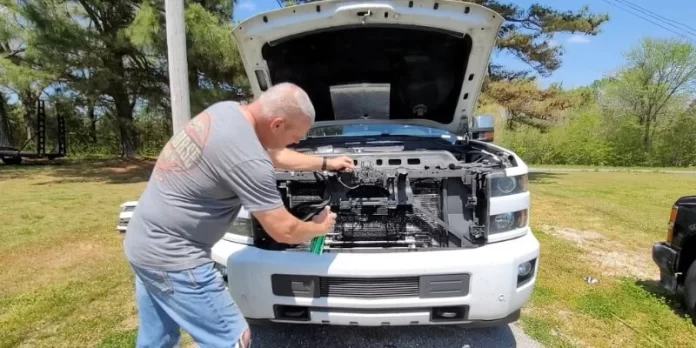A dirty and clogged car air conditioning condenser can cause bad AC performance. Therefore, regularly cleaning the condenser will enhance its excellent performance and increase the AC’s efficiency.
When you service your car’s AC condenser, you will certainly enjoy efficiency and effectiveness.
Let’s go over the procedures on how to clean a car’s AC condenser. You don’t have to stress too much; follow the steps highlighted in this article, and you’re good to go!
Tools for Cleaning Car’s AC Condenser
Cleaning a Car’s AC condenser is a very delicate process. You must do it cautiously with the appropriate tools and products.
This will include the tools you’ll use for brushing, rinsing, and applying the cleaning solution. Some of the products and tools include:
Screwdriver
This tool is used to remove some screws to be able to detach the bumper and access the car’s AC condenser easily.
A Shop-vac
This brush is used to remove debris stuck in the condenser. Notwithstanding, if you don’t have this particular brush type, you can improvise with a soft-bristled brush.
Coil cleaner
With this, you’ll be able to get rid of the grease and grime from the condenser. First, however, ensure you get the coil cleaner used for cleaning AC condensers.
Using just any degreaser or cleaner may affect the condenser’s aluminum, causing corrosion.
Besides, most coil cleaners are concentrated solutions that you’ll dilute before usage. Others come in ready-made spray bottles, and you can spray them on the condenser. Then, it’ll form lathes, and you start rinsing.
Garden hose
This tool is used to rinse the cleaning solution (cleaner) off the car’s AC condenser. Avoid using a washer (pressure) because the fins of the condenser are delicate and could damage if pressure is applied.
Protection pieces
The protection apparatuses include safety boots, masks, and gloves. All of this help to prevent irritation and dust from harming your health.

How to Clean Car’s AC Condenser: Just Follow these 8 Steps!
With the help of an effective coil cleaner that has active foaming action, you’ll be able to get grease and grime off your AC condenser. The cleaning process is easy.
You don’t need to fuss! Instead, carefully follow the steps highlighted below:
1. Remove your car’s front bumper.
The first point of action for cleaning the condenser is to take out the front bumper. The location of the bolts, clips, and screws will vary in cars depending on the make and model. If you’re unsure where they’re located, consult your car manual.
To take out the bumper, open the car hood. Next, remove all the screws, bolts, and clips that need to be removed to take out the front bumper easily. After that, you’ll be able to access the main AC condenser.
2. Follow the necessary safety precautions before you begin cleaning the condenser.
Ensure you turn your car off and allow it to cool down, especially if you used it before the cleaning. Do everything with caution, so you don’t damage your car engine. The best way to do this is to use garbage bags to cover all the delicate parts of the car that may likely become wet and easily damaged.
3. Brush off all debris and dirt from the Car’s AC condenser
Go ahead and remove any debris and dust stuck inside your air conditioner. Use a soft bristle brush or vacuum cleaner to do this job. Don’t apply too much force on the brush so you won’t damage the fin of the AC condenser unit.
4. Apply coil cleaner on the Car’s AC condenser
Ensure that all debris and dirt have been removed, then liberally apply coil cleaner to the condenser. If the condenser is composed of two parts, be sure to clean each part separately. Before applying the cleaner to the condenser, ensure the spray bottle is adequately shaken.
Immediately you apply the cleaner; foam lathes will start forming. Allow it to remain on the condenser’s surface for about five to fifteen minutes to get rid of the grease and grime completely.
5. Rinse the AC condenser
After allowing the cleaner to sit for some minutes, rinse the cleaner using a hose till all the lathes are gone. Be careful not to wet the engine’s wires so it doesn’t cause the circuit to be short. Most importantly, the engine must not be during this process. If the AC is of two parts, repeat the process on the other side.
6. Allow the Car’s AC condenser to dry
The water used in rinsing the condenser must dry off before you do anything else. To make the process faster, you can blow the water out using an air compressor and a blowgun if you have one.
7. Take out the garbage bags and clean the surrounding areas of the bumper and AC condenser.
After you’ve successfully cleaned the grease and grime in the condenser and rinsed it, you can take out the garbage bags that were used to secure the engine of the car. Don’t forget to clean the surrounding areas of the AC condenser and front bumper.
8. Reinstall the front bumper
Just as you removed the bumper, put it back in place and fix all the bolts, clips, and screws you took out.

Tips on Car’s AC Condenser Cleaning
Experts recommend the following for cleaning car AC condensers:
Keep debris and dirt away from the AC compartment. Anytime you notice any debris stuck in any AC compartments, brush it out.
Always turn off the fans of the AC condenser before stopping your vehicle to prevent mold from developing on the AC vents.
If you intend to clean your car’s AC condenser after driving, ensure the engine cools down before you start the cleaning process
Clean the vents at least every two to three months using a fan blower.
FAQs
All you
How to clean a car AC condenser without removing it?
All you need to do is:
- Take out the glove box
- Locate the evaporator coil and apply the cleaner to it through the access point
- Rinse the coil and allow it to dry
- Replace the blower fan
- Return the glove box
What is the difference between an evaporator and a condenser?
The evaporator is the part of the AC system that removes moisture and heat from the air indoors to cool it. On the other hand, the condenser takes the moisture and heat and sends it outside.
Can you flush an AC condenser?
Yes, you can flush the condenser (if it is contaminated with foreign materials) and even the hoses and evaporator. But, you can’t flush the expansion valve, orifice tube, compressor or accumulator.
What will a dirty condenser cause?
There’ll be a sudden increase in energy bills because the coils of the dirty condenser will block the cooling effect of the AC system. Hence, the AC will have to push harder and longer to send out the cooling air. This blockage will cause the cooling bills to go high since the system will consume more energy than it’s supposed to.
Are there any symptoms of a dirty AC condenser?
Once the AC condenser is dirty, it’ll be unable to reject heat as its primary function is to condense the vapor of the refrigerant into liquid. As a result, a high condensing temperature will cause a high discharge temperature.
Conclusion
A clean car’s AC condenser is an assurance of smooth and optimal performance. You don’t need to be tutored on how to clean your car’s AC condenser. It’s a simple DIY project!
However, we’ve extensively explained the steps to follow. So, get started with the cleaning process to keep your car’s AC system functioning in perfect condition.




Insightful piece